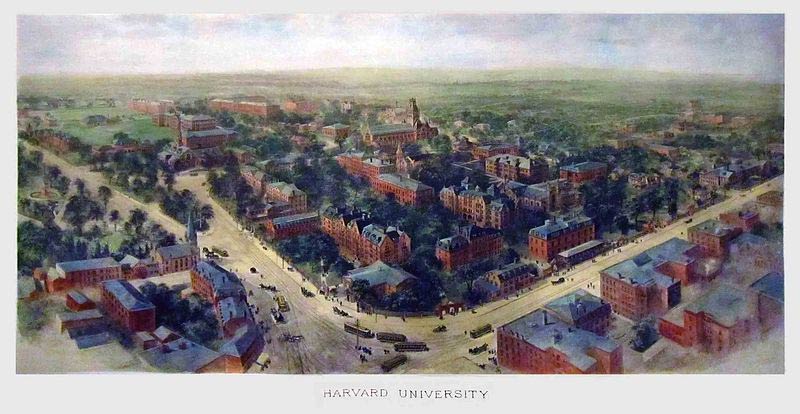 Harvard University was founded in 1636 by vote of the Great and the General Court of the Massachusetts Bay Colony. It is the oldest institution of higher learning in United States. It was named after the college’s first donor, the Reverend John Harvard, who, after his death, left half of his estate and his personal library to the new institution. A statue of John Harvard was built in front of the University hall in the Yard of the Harvard University and is the best known landmark of the University. Harvard University is one of the eight esteemed “Ivy League” schools in the Northeast United States. Harvard Alumni include famous and significant personalities in American history.
Harvard University was founded in 1636 by vote of the Great and the General Court of the Massachusetts Bay Colony. It is the oldest institution of higher learning in United States. It was named after the college’s first donor, the Reverend John Harvard, who, after his death, left half of his estate and his personal library to the new institution. A statue of John Harvard was built in front of the University hall in the Yard of the Harvard University and is the best known landmark of the University. Harvard University is one of the eight esteemed “Ivy League” schools in the Northeast United States. Harvard Alumni include famous and significant personalities in American history.
Early History of Harvard University
In 1636, Harvard University came into existence, however it did not have a single instructor, student or building. It was re-named in 1639 in honor of its deceased benefactor, Charlestown minister John Harvard. For its first two centuries of existence, Harvard University followed a set curriculum that was consistent with the instructional style of its time period. This curriculum included basic educational courses with a Puritanical outlook. It emphasized rote learning, constant drilling and rhetorical principles. In the beginning the faculty was quite small, yet they were all famous and distinguished individuals. For example, John Winthrop, who taught philosophy and mathematics, was one of the greatest men of science during the colonial period of the United States. In these early years, like many universities, Harvard did not accept or teach to women. It was not until the year 1879, that Harvard University slowly began to accept some women to attend their college lectures. Radcliffe, a nearby women’s university, was closely tied to Harvard University and often paid its professors to repeat their lectures for their female students. Despite these close ties and collaboration, the Radcliffe school was not formally merged into Harvard until 1999.
Architectural History
The buildings in Harvard University are very old and date back to the 18th century. Wadsworth House, Holden Chapel and Massachusetts Hall are the oldest ones. Hollis Hall was built in 1763 and serves as a dormitory. Harvard Hall burnt down during a fire in 1764, which also destroyed the college library (which was the largest library in North America at the time), the scientific apparatus and the whole laboratory. During the Revolution, the Old Stoughton College was occupied by Continental troops and it suffered so much damage that it was torn down in 1781. Later on, Holworthy Hall, Stoughton Hall and University Hall were all newly constructed. During the mid of 18th century, a scientific school, an observatory laboratory, a natural history museum and a chemistry laboratory were built.
In 1910, Harvard Corporation formally designated crimson as its official color.
Early Academic Programs at Harvard University
In 1642 was the year that the first students of Harvard University graduated. In the beginning, Harvard provided learned ministry to the colonies. As time went on, many more graduate programs were created and introduced to the curriculum, however, it wasn’t until the 18th century that it would be fully converted into a University. The variety and number of courses increased during the presidency of Charles William Eliot. The older methods of recitation were replaced and students were free to choose their desired courses. Lawrence Lowell introduced the new method of scholarship and honors work, under which emphasis was laid on the system of “distribution and concentration” and included tutorials and general examinations. In 1780, Harvard University became a full-fledged university. And in the late eighteenth century, Harvard University started granting higher degrees.
During the 20th century, new buildings for professional schools were constructed: the building for Medicine school in 1906; the building for Law school in 1907, and a Business Administration building in 1926. The Central Library building dates back to 1915, the Mallinckrodt Chemical Laboratory was built in 1929 and Fogg Museum in 1927.
Growth of Harvard University during the Pusey and Bok periods
Pusey period marked the major growth and development period for the Harvard University. Under the government subsidy for science, major facilities were provided in the areas of public health, medicine and applied sciences. Faculty salary structure was improved by fund-raising campaigns. New professorships were created and student financial aid was increased.
Derek Curtis Bok was Pusey’s successor and during his 21 year presidency, the University observed an unprecedented growth. Capital for University funds was collected from private sources and Core Curriculum was formed to broadly educate every Harvard undergraduate.
Today, Harvard University boasts a very prestigious Faculty of Arts and Sciences. Harvard is made up of 11 principal academic units that include Graduate School of Arts and Sciences, Division of Continuing Education, the School of Engineering and Applied Sciences, Business Administration, Divinity, Design, Government, Medicine and Public Health and the Radcliffe Institute for Advanced Study. The campus area is approximately 500 acres, concentrated in Boston and Cambridge. Every year, around 2100 students receive admission to Harvard. Harvard University is one of the most selective and sought after colleges in the world.